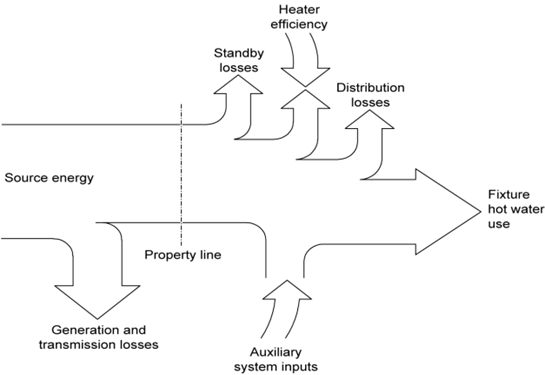
Chapter 5 describes the compliance requirements for domestic water heating for newly constructed residential dwellings, including single-family, duplex, triplex, and townhouses. This chapter also describes common water heater types, best practices for water heater maintenance, hot water distribution system designs, and examples of commonly asked questions regarding compliance with Energy Codes requirements. For general information about compliance and enforcement please see Chapter 2 of this compliance manual. For information about water heating requirements for additions and alterations, please see Chapter 9.
This section summarizes changes to the requirements for residential water heating for the 2022 Energy Codes. Please see Sections 5.3 and 5.4 for detailed information on the mandatory and prescriptive water heating requirements in the 2022 Energy Codes.
1. Simplify the hot water piping language and align with the Plumbing Code.
2. Updated HPWH ready requirements for gas water heater installations that includes providing a designated space for a future HPWH installation (see Electric Readiness – Chapter 10).
Water heating equipment is required to be a heat pump water heater or a solar water heating system with electric backup and minimum 70% solar fraction. In Climate Zones 3, 4, 13, and 14 a gas instantaneous water heater is allowed. (§150.1(c)8)
When the performance compliance method is used, the energy budget is based on the performance of a heat pump water heater in all climate zones except 3, 4, 13, and 14, where the energy budget is based on a gas instantaneous water heater. For more information, see Section 5.5.
Table 5-1 provides an overview of the location of the water heating requirements in the 2022 Energy Codes by construction and building type.
Table 5-1 Overview of Water Heating Requirements in the Energy Codes and This Chapter
|
Type |
Mandatory Requirements
|
Mandatory Requirements
|
Prescriptive
Requirements |
Prescriptive
Requirements |
Performance
Requirements |
Performance
Requirements |
|
Single-family dwelling |
5.3 |
i, ii, iii, iv, v |
5.5 | |||
|
Addition |
5.3, 9 |
5.5 | ||||
|
Alteration |
5.3, 9 |
5.5 |
Source: California Energy Commission
Water Heating Energy
Total energy use associated with water heating consists of the end use, heater inefficiencies, standby loss, and distribution system inefficiencies. Figure 5-1 below shows the energy flows that constitute water heating energy usage. Hot water draws at the end use points (for example, faucets, showers, and so forth) represent the useful energy consumed. In most cases, hot water that is actually used represents the largest fraction of water heating energy use, although in situations when there are very few hot water draws, standby losses from a standard gas storage water heater and the hot water distribution system can exceed the quantity of useful energy consumed at the end point. Energy impacts associated with the hot water distribution system vary widely based on the type of system, quality of insulation and installation, building and plumbing design, and hot water use patterns. Distribution losses in a typical single-family home may be as much as 30 percent of the total energy used for water heating. Distribution losses in single-family homes with compact hot water distribution systems may be lower than 10 percent of total water heating energy use. In a typical multifamily building, distribution losses can account for more than 30 percent of total water heating energy use. An important consideration for any water heating system is the recovery load (that is, end use plus distribution losses) of the water heating unit minus any contribution from auxiliary heat inputs, such as a solar thermal system.
Figure 5-1: Water Heating Energy Flow Representation
